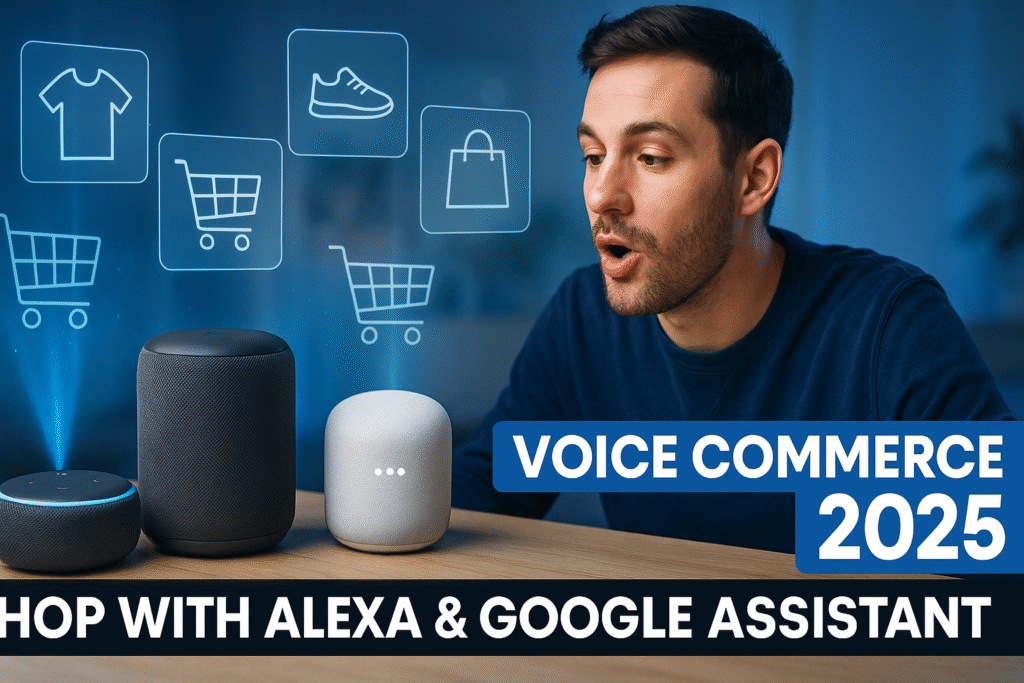Introduction: The Rise of Voice Commerce
The way we shop is changing — and voice assistants are leading the revolution.
In 2025, platforms like Amazon Alexa and Google Assistant have transformed from smart home helpers into powerful retail channels, enabling users to buy products, compare prices, and manage their shopping lists — all hands-free.
The concept of Voice Commerce (v-commerce) is no longer futuristic. It’s real, measurable, and growing exponentially. According to OC&C Strategy Consultants, global voice commerce sales are expected to reach $80 billion by 2025, with retail, groceries, and personal care leading the surge.
This blog explores how voice technology is changing retail, how brands are leveraging AI assistants, and what the future holds for v-commerce.
🗣️ What Is Voice Commerce?
Voice Commerce refers to buying products and services using voice commands through smart devices.
Instead of:
- Searching online
- Adding to cart
- Entering payment details
You simply say:
“Alexa, order my favorite coffee pods.”
Or:
“Hey Google, reorder diapers from Amazon.”
V-commerce combines AI, natural language processing, and seamless payments to make shopping faster, personalized, and hands-free.
🔹 Why Voice Commerce Is Taking Off
Several trends are driving the rapid adoption of voice commerce in 2025:
1. Smart Speaker Penetration
- Over 400 million smart speakers are in use globally, with Amazon Echo and Google Nest leading.
- Households now have multiple devices, making voice a natural interface for shopping.
2. Seamless Payments & Subscriptions
- Integration with digital wallets, UPI, Apple Pay, and Google Pay has removed friction.
- Reordering essentials (milk, groceries, household items) can happen in under 30 seconds.
3. Personalized AI Recommendations
- Alexa and Google Assistant now learn from purchase history, browsing patterns, and preferences, offering personalized product suggestions.
4. Busy Lifestyle & Multi-Tasking
- Users cook, clean, or drive while placing orders — voice shopping fits hands-free lifestyles perfectly.
🛒 How Alexa Is Shaping Retail
Amazon’s Alexa is not just a virtual assistant — it’s a direct sales channel.
🔹 Key Features Driving Alexa Commerce
- One-Click Voice Ordering
Users can set default products for fast reordering, including groceries, household essentials, and personal care. - Smart Recommendations
Alexa suggests products based on past purchases, seasonal trends, and even complementary items.
Example: If you bought coffee pods last month, Alexa might suggest a new flavor or matching milk frother. - Integration With Amazon Prime
Prime members enjoy faster delivery, personalized offers, and curated product suggestions via voice. - Voice Shopping for Entertainment & Digital Products
Users can buy eBooks, Audible audiobooks, and subscriptions without lifting a finger.
📈 Why Alexa Excels in V-Commerce
- Seamless integration with Amazon’s massive inventory
- Smart AI recommendations increase average order value (AOV)
- Builds brand loyalty through repeated voice interactions
🗺️ Google Assistant: The Search Giant Enters Retail
Google Assistant leverages search data, local business listings, and Google Shopping to provide a competitive edge in voice commerce.
🔹 Google Assistant’s V-Commerce Features
- Hands-Free Shopping Across Platforms
Users can place orders on Walmart, Target, Flipkart, or local stores with a single voice command. - Price Comparison & Smart Suggestions
Google Assistant can compare prices in real-time, show discounts, and offer best deals, giving users more control. - Integration With Google Pay
Enables instant checkout, recurring payments, and subscription management via voice. - Contextual Shopping
Google Assistant can recommend products based on calendar events, locations, and habits.
Example: “You have a birthday party tomorrow — would you like to order a cake?”
🧠 How AI Powers Voice Commerce
AI is the backbone of v-commerce. Alexa, Google Assistant, and other voice assistants use Natural Language Processing (NLP), machine learning, and predictive analytics to:
- Understand complex queries (“order my usual snacks from Amazon and schedule delivery for tomorrow morning”)
- Predict user preferences and reorder habits
- Provide personalized suggestions based on habits, location, and seasonality
- Improve voice recognition across accents and languages
By 2025, AI ensures voice commerce is accurate, intuitive, and context-aware, enhancing customer trust and adoption.
🛍️ Industries Benefiting from Voice Commerce
Voice commerce isn’t limited to e-commerce giants — multiple industries are seeing growth:
- Grocery & Essentials
Voice shopping simplifies weekly orders, including milk, bread, fruits, and cleaning supplies. - Fashion & Accessories
While voice isn’t perfect for size selection yet, brands use it for reordering favorites, checking stock, or scheduling virtual fitting sessions. - Healthcare & Personal Care
Users can reorder prescriptions, vitamins, and wellness products using Alexa and Google Assistant. - Entertainment & Digital Media
Audiobooks, movies, music subscriptions, and online courses can all be purchased hands-free. - Home & Appliances
Smart devices themselves can initiate reorders for consumables, like printer ink or air filters.
🔹 Case Studies: Brands Winning with V-Commerce
1. Amazon & Alexa
- Millions of Prime users reorder essentials monthly through Alexa.
- Alexa Skill Store helps small brands integrate their catalog for voice shopping.
2. Walmart + Google Assistant
- Walmart users can place grocery orders with voice commands, schedule pickup or delivery, and track orders in real-time.
3. Nestlé & Procter & Gamble
- Brands offer voice-exclusive discounts and subscription bundles for repeat buyers via Google Assistant.
4. Unilever
- Uses voice assistants to suggest products based on past purchase history and location, improving customer retention.
💡 Benefits of Voice Commerce for Retailers
- Higher Customer Engagement
- Voice offers a conversational interface, increasing brand stickiness.
- Repeat Purchases & Loyalty
- One-touch reordering encourages recurring sales and subscriptions.
- Data-Driven Insights
- Voice assistants track purchase trends, enabling targeted promotions.
- Reduced Friction in Checkout
- No cart abandonment — voice commerce is fast and effortless.
- Accessibility & Convenience
- Ideal for busy professionals, senior citizens, and visually impaired users.
📊 Voice Commerce by the Numbers (2025)
| Metric | Alexa | Google Assistant | Other Platforms |
|---|---|---|---|
| Smart Speaker Users | 140M | 120M | 50M+ |
| % Using for Shopping | 28% | 25% | 18% |
| Avg Order Value | $42 | $39 | $35 |
| Repeat Purchase Rate | 62% | 58% | 50% |
Source: OC&C, Statista, Insider Intelligence, 2025
Voice commerce is not a small trend — it’s a multi-billion-dollar retail channel.
🛠️ Challenges in Voice Commerce
While voice commerce is booming, retailers face hurdles:
- Limited Product Details
- Users rely on descriptions rather than visuals; suitable mainly for repeat or familiar products.
- Voice Recognition Accuracy
- Accents, background noise, and language variations can cause errors.
- Payment Security & Privacy
- Sensitive transactions require strong authentication, including biometric verification.
- Limited Cross-Selling Opportunities
- Suggesting additional products is harder without a visual interface.
Despite these challenges, AI improvements and better user interfaces are rapidly closing the gap.
🔮 The Future of Voice Commerce
By 2030, experts predict:
- AI will fully understand context — e.g., “order my usual items for weekend breakfast” without specifying brands.
- Voice + AR Integration — Users can see products via smart glasses while placing orders.
- Global Multi-Language Support — Shopping in native languages anywhere in the world.
- Predictive Reordering — Devices will automatically reorder essentials based on consumption patterns.
- Seamless Omnichannel Experience — Voice orders linked with store pickup, delivery apps, and subscription services.
Voice commerce will be an invisible, intuitive, and indispensable part of everyday life.
🏁 Conclusion: Hands-Free Shopping Is the Future
Voice commerce is no longer optional — it’s becoming a central retail channel in 2025.
- Alexa transforms your home into a personal retail hub.
- Google Assistant bridges search, shopping, and payment seamlessly.
- Retailers gain repeat business, personalized engagement, and invaluable insights.
In the coming years, hands-free shopping will redefine convenience, efficiency, and personalization. The future of retail isn’t just online — it’s spoken aloud.
The era of voice commerce is here. Speak, and your shopping is done. 🎙️🛒


